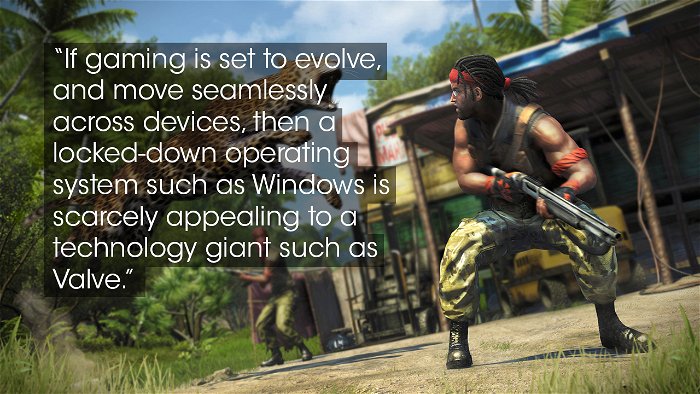2013 happens to be a rarity in the annals of video gaming. It’s one of those unusual years in which a new cutting-edge console generation is launched.
Admirable as it may be, a new handheld or mobile gaming platform just isn’t going to generate the same kind of popular interest as the launch of a new PlayStation.
This will all be recognisable by the stereotypical representation of gamers in the media; cue slack-jawed news anchors reciting sales figures and expressing bewilderment over customers camping out in front of Target at midnight as if it’s a new thing.

Just as predictable as this will be the wave of naysayers keen to point at the monstrous retail figures for console gaming and auger some kind of collapse of the personal computer as a viable gaming platform. After all, the statistics are damning; in July this year, research firm Garner released figures showing that global PC sales fell for the fifth quarter in a row. It’s the longest decline in sales in the history of the platform.
Many are now questioning if PC gaming is on the verge of disappearing. And if so, what exactly is needed to prevent PC gaming from ever being pushed aside by consoles, or tablets, or other technology yet to see the light of day?
A Question Of Advocacy
For the most part, the popular perception of modern gaming is very much tied to advertising. The more money a company can spend on getting its message across, the more likely it is that the public will align their view of the product with the image the company wishes to present.
Microsoft, Sony and Nintendo have massive advertising budgets designed to push their hardware offering to the forefront of public consciousness. TV spots, billboards, road shows, competitions – there’s virtually no avenue of advertising that remains unexplored for the clever promotion of a console.

The PC has no such collective advocacy. It isn’t even locked down to a particular hardware vendor, or even a single operating system. It’s a loose collection of partners who adhere to various technology standards in a quest to produce faster and more efficient computing devices. With some exceptions, (predominantly in the graphics sector) PC hardware manufacturers have little interest in promoting the video game industry, and certainly no interest in pushing individual blockbuster titles in the direction of platform exclusivity.
This may seem irrelevant in the light of the massive budgets available to game publishers, but it’s a significant factor during the production cycle of any game. Virtually all games, after all, are written on personal computers and pushed out to consoles for testing. Console manufacturers take a cut from each title released, actively provide support during development and testing, and often provide the back-end for network interoperability.
The Face Of The PC
The closest PC gaming has ever had to collective support comes largely from software vendors. Valve’s Steam platform features more than 2000 downloadable titles and 60 million active users and yet has no loyalty to any particular hardware supplier.
Steam has always been predominantly Windows based, but even that may be about to change. Microsoft continues to shred company value in an unwinnable battle against Android and iOS—not to mention the promotion of Windows 8 to a user base that simply doesn’t need it. Meanwhile, Valve has quietly extended the development of Linux, porting over at least 200 games to its SteamOS operating system in addition to developing its own hardware in the form of the Steam Box.
There’s no question that Valve’s vision of the near gaming future features a heavy dose of open-source reality. If gaming is set to evolve, and move seamlessly across devices, then a locked-down operating system such as Windows is scarcely appealing to a technology giant such as Valve.
Even cloud-based alternates such as OnLive have shown that gaming needn’t be relegated to a specific hardware or software solution. By streaming the entire content to the user over a data connection, the only limiting factor is latency and whatever peripherals are available to control the game. Admittedly, OnLive may be a little too ahead of practical technology, but the fact that it has customers is proof enough of concept.
Before lamenting or even considering the loss of the PC gaming sector, it’s necessary to examine concerns that didn’t exist ten or fifteen years ago. Namely, if PC gaming isn’t tied down to any particular hardware, nor is its popularity dependent on a specific operating system, what exactly is it, and how will we know when it’s gone?




